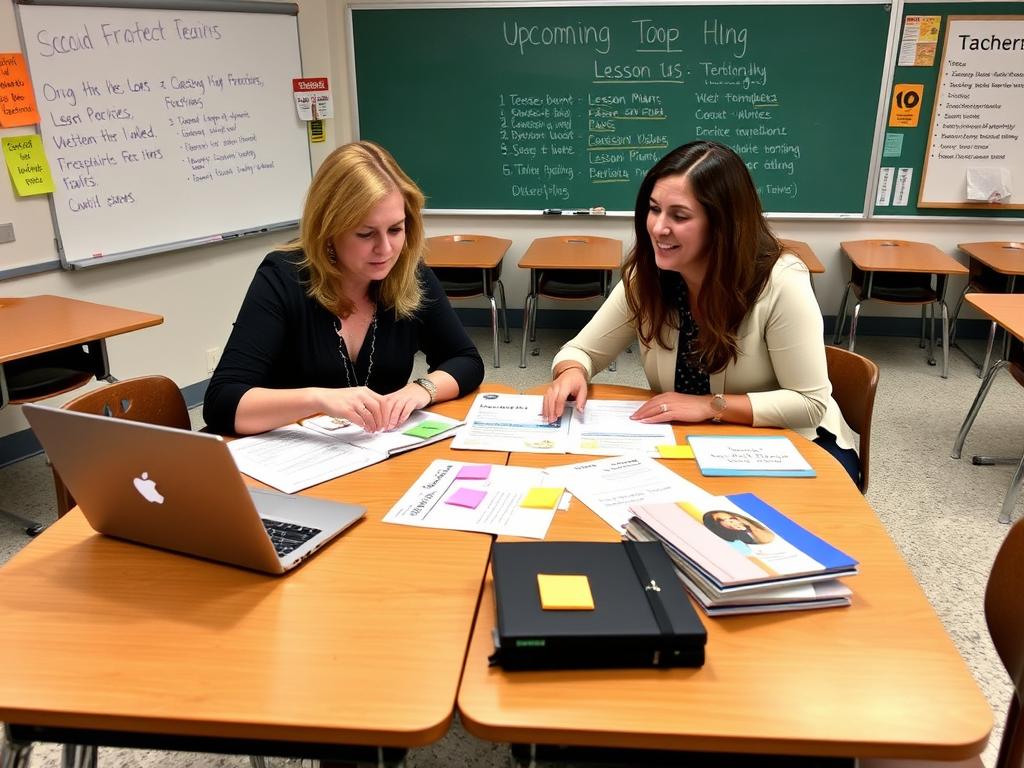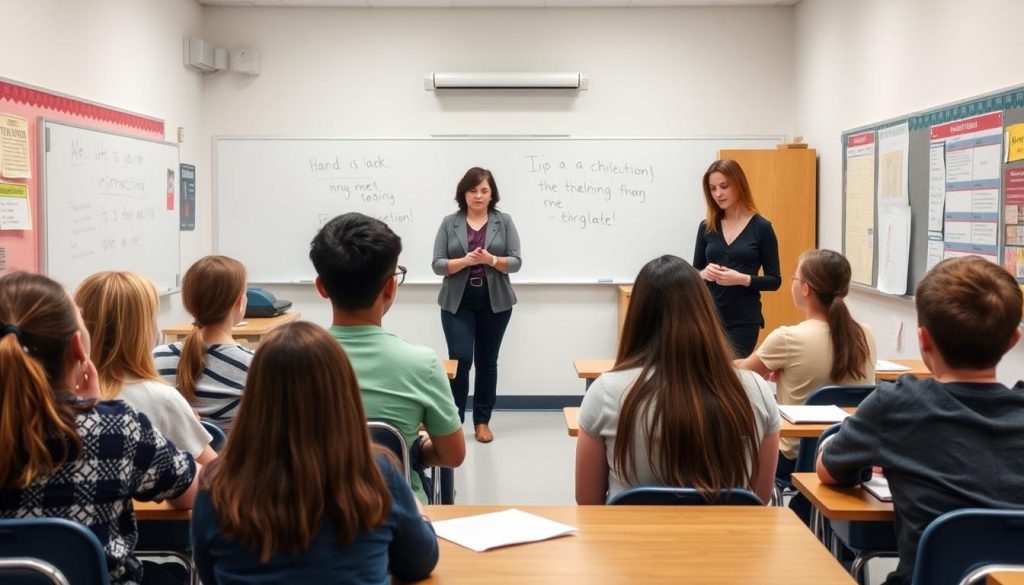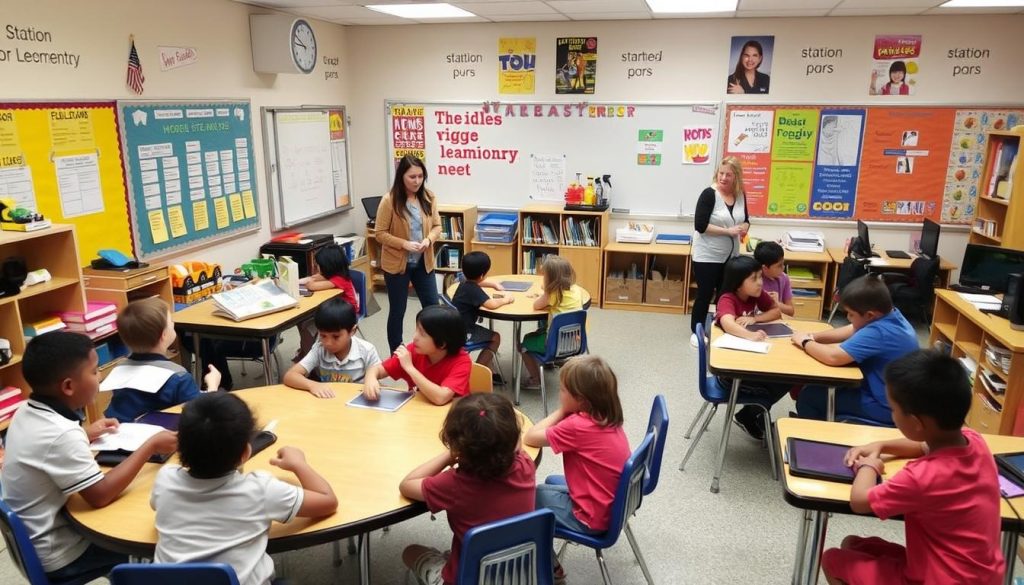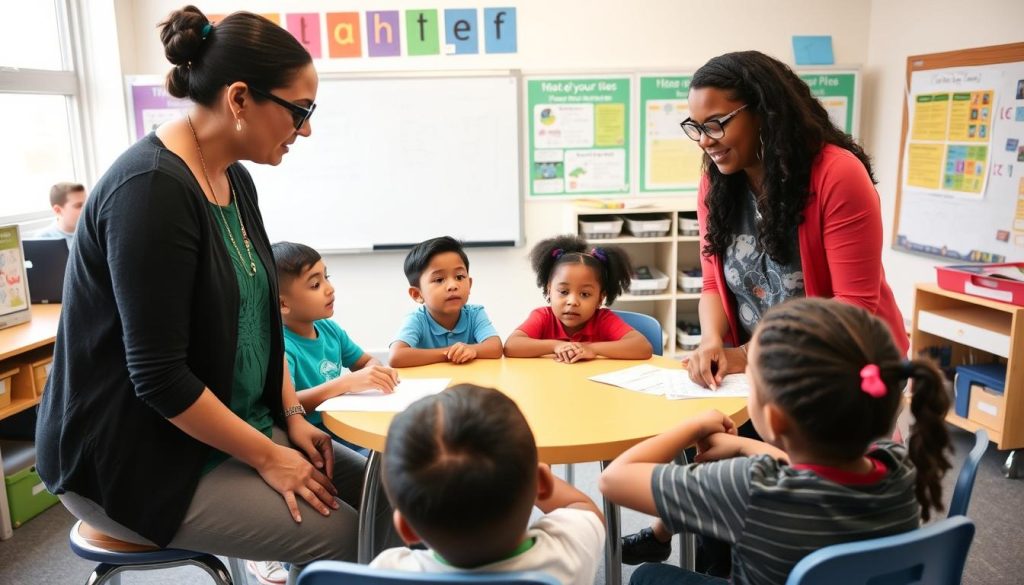Understanding Co-Teaching Strategies: The Basics
Effective co-teaching involves collaborative planning and shared responsibility for student learning.
Co-teaching occurs when two educators share responsibility for planning, instructing, and evaluating a group of students. Unlike the traditional “one teacher, one classroom” model, co-teaching strategies leverage the strengths and expertise of multiple educators to better meet diverse student needs. This approach is particularly valuable in inclusive classrooms where students with varying abilities learn together.
The foundation of successful co-teaching lies in developing specific teacher skills that facilitate collaboration. These include communication, flexibility, content knowledge, and the ability to differentiate instruction. When two teachers combine their unique teacher skills and perspectives, students benefit from enhanced learning opportunities and more individualized attention.
The Six Models of Co-Teaching
Before diving into the dos and don’ts, it’s important to understand the six primary co-teaching models that form the backbone of most collaborative teaching approaches:
Team Teaching
Both teachers deliver instruction simultaneously, seamlessly trading off teaching responsibilities. This requires strong teacher skills in coordination and mutual trust.
Parallel Teaching
The class is divided into two groups, with each teacher instructing one group on the same content. This reduces the student-teacher ratio and allows for more interaction.
Station Teaching
Students rotate through various learning stations, some led by teachers and others designed for independent work. This model leverages organizational teacher skills.
Alternative Teaching
One teacher works with a small group while the other teaches the larger group. This is ideal for remediation, pre-teaching, or enrichment activities.
One Teach, One Assist
One teacher leads instruction while the other circulates to provide support. This model requires clear role definition to be effective.
One Teach, One Observe
One teacher leads while the other gathers specific observational data about students or instruction. This approach helps inform future teaching decisions.
Understanding these models is just the beginning. The real art of co-teaching lies in knowing when and how to implement each approach based on your learning objectives, student needs, and the specific teacher skills each educator brings to the partnership.
Ready to Master Co-Teaching?
Enhance your teacher skills with professional development designed specifically for co-teaching environments. Our comprehensive courses help you implement effective co-teaching strategies in your classroom.
Co-Teaching Strategies: The Essential Dos

Collaborative planning is essential for successful co-teaching partnerships.
Successful co-teaching begins with intentional practices that build a strong foundation for collaboration. These “dos” represent the core teacher skills and approaches that make co-teaching truly effective.
DO: Establish Clear Roles and Responsibilities
One of the most crucial teacher skills in co-teaching is the ability to clearly define and communicate roles. Research shows that co-teaching partnerships thrive when both educators understand their responsibilities for each lesson and unit.
- Discuss and document who will lead different parts of lessons
- Play to each teacher’s strengths and expertise
- Rotate roles regularly to maintain equity in the partnership
- Be explicit about who handles grading, parent communication, and behavior management
- Revisit and adjust roles as the school year progresses
DO: Prioritize Co-Planning Time
Effective co-teaching strategies require dedicated planning time. This essential teacher skill—collaborative planning—ensures that both educators are aligned on objectives, approaches, and student needs.
- Schedule regular, protected co-planning sessions
- Use digital tools to collaborate asynchronously when needed
- Create shared lesson plan templates that work for both teachers
- Discuss differentiation strategies for diverse learners
- Plan for multiple co-teaching models within a unit
DO: Communicate Openly and Honestly
Communication is perhaps the most important teacher skill for successful co-teaching. Partners must be able to share ideas, concerns, and feedback in a constructive manner.
- Establish norms for giving and receiving feedback
- Address concerns promptly before they become larger issues
- Celebrate successes and acknowledge each other’s contributions
- Be willing to compromise and find middle ground
- Use “we” language when discussing the class with students and parents
DO: Present a United Front to Students
Students quickly notice when teachers aren’t aligned. Developing the teacher skill of presenting as a cohesive team helps establish classroom authority and consistency.
- Refer to your co-teacher as an equal partner in the classroom
- Align on classroom procedures and expectations
- Support each other’s decisions in the moment (discuss disagreements privately)
- Share the physical space equitably (both teachers should have a desk or home base)
- Model respectful collaboration for your students
Implementing these co-teaching strategies consistently helps build a strong partnership that benefits both teachers and students. When both educators feel valued and understand their roles, the classroom becomes a more dynamic and responsive learning environment.
Build Your Co-Teaching Toolkit
Looking for practical resources to implement these co-teaching strategies? Credits for Teachers offers downloadable templates, planning guides, and professional development opportunities designed specifically for co-teaching partnerships.
Co-Teaching Strategies: Common Pitfalls to Avoid

Avoiding the “one teach, one watch” scenario is crucial for effective co-teaching.
Even experienced educators with strong teacher skills can fall into common co-teaching traps. Being aware of these pitfalls is the first step toward avoiding them and creating more effective partnerships.
DON’T: Create an Unequal Partnership
One of the most common mistakes in co-teaching is allowing one teacher to become the “real” teacher while the other is relegated to an assistant role. This undermines the core purpose of co-teaching and wastes valuable teacher skills.
Signs of an Unequal Partnership
- One teacher consistently leads while the other only assists
- The special education teacher works exclusively with students with IEPs
- Only one teacher’s name appears on communications and assignments
- Students direct all questions to one teacher
- One teacher makes unilateral decisions about curriculum and assessment
DON’T: Neglect Co-Planning Time
When schedules get busy, co-planning is often the first thing sacrificed. However, skipping this crucial step undermines the teacher skills needed for effective collaboration and reduces co-teaching to simple turn-taking.
Consequences of Skipping Co-Planning
- Disjointed lessons that lack cohesion
- Missed opportunities for differentiation
- One teacher being unprepared or uninformed
- Reverting to the “one teach, one assist” model by default
- Reduced student engagement and learning
DON’T: Use Only One Co-Teaching Model
Relying exclusively on a single co-teaching approach limits the potential benefits of collaboration and prevents teachers from developing the full range of teacher skills needed for effective co-teaching.
Limitations of a Single-Model Approach
- Fails to address diverse student learning needs
- Creates predictable routines that may bore students
- Doesn’t leverage the full range of both teachers’ skills
- May reinforce unequal roles between co-teachers
- Limits opportunities for small group instruction
DON’T: Avoid Difficult Conversations
Co-teaching requires strong interpersonal teacher skills, including the ability to address conflicts and differences professionally. Avoiding necessary conversations leads to resentment and ineffective partnerships.
Problems with Conflict Avoidance
- Unresolved issues that grow over time
- Passive-aggressive behaviors that students notice
- Decreased job satisfaction for both teachers
- Missed opportunities for professional growth
- Modeling poor conflict resolution for students
By recognizing and actively avoiding these common pitfalls, co-teachers can build stronger partnerships and more effective learning environments. Remember that developing the teacher skills needed for successful co-teaching is an ongoing process that requires reflection and adjustment.
Co-Teaching Strategies: Elevating Your Practice

Advanced co-teaching strategies like station teaching maximize student engagement and teacher effectiveness.
Once you’ve mastered the basics and avoided common pitfalls, it’s time to elevate your co-teaching practice. These “do betters” represent advanced teacher skills that can transform good co-teaching into exceptional collaborative instruction.
DO BETTER: Implement Data-Driven Grouping
Moving beyond simple convenience grouping, skilled co-teachers use assessment data to create purposeful student groups that target specific learning needs.
- Use formative assessment data to create flexible groups that change based on student needs
- Track the effectiveness of different grouping strategies
- Ensure groups are diverse and avoid stigmatizing students
- Plan different approaches for different groups while maintaining common learning goals
- Regularly reassess and regroup based on ongoing assessment
DO BETTER: Develop Seamless Transitions Between Models
Advanced co-teaching involves the teacher skill of fluidly moving between different co-teaching models within a single lesson or unit based on instructional goals.
- Plan intentional transitions between co-teaching approaches
- Create visual or verbal cues that signal model shifts to students
- Practice transitions to ensure they don’t waste instructional time
- Match specific models to particular learning objectives
- Reflect on which transitions work best for your students
DO BETTER: Co-Assess with Precision
Beyond co-planning and co-teaching, effective partners develop the teacher skill of collaborative assessment that leverages both educators’ perspectives.
- Create common rubrics that reflect both teachers’ input
- Occasionally grade the same work independently, then compare evaluations
- Divide assessment responsibilities strategically based on expertise
- Use assessment data to inform future co-teaching approaches
- Provide students with rich feedback that reflects multiple perspectives
DO BETTER: Engage in Reflective Practice
The most effective co-teachers develop the teacher skill of ongoing reflection, constantly evaluating and improving their collaborative practice.
- Schedule regular reflection meetings focused solely on improving co-teaching
- Keep a shared journal of what works and what doesn’t
- Observe other co-teaching pairs and invite feedback on your practice
- Set specific co-teaching goals for improvement each quarter
- Celebrate growth and acknowledge challenges honestly
These advanced co-teaching strategies require time, trust, and commitment to develop. However, the investment pays off in more engaging instruction, better student outcomes, and more satisfying professional relationships. As you refine these teacher skills, you’ll discover that effective co-teaching truly is greater than the sum of its parts.
Take Your Co-Teaching to the Next Level
Ready to implement these advanced co-teaching strategies? Our specialized professional development program provides the tools, templates, and techniques you need to transform your co-teaching practice.
Implementing Co-Teaching Strategies: A Practical Timeline
A strategic timeline helps co-teachers implement different strategies at appropriate times throughout the school year.
Implementing effective co-teaching strategies requires thoughtful planning and a gradual approach. This timeline provides a framework for developing essential teacher skills and introducing different co-teaching models throughout the school year.
Before the School Year
- Establish the partnership: Meet to discuss teaching philosophies, strengths, and areas for growth
- Set up the physical space: Arrange the classroom to accommodate various co-teaching models
- Create shared systems: Develop common approaches to grading, communication, and classroom management
- Plan the first unit: Start with detailed co-planning for the first few weeks
First Quarter
- Begin with simpler models: Start with One Teach, One Assist and Team Teaching to establish rapport
- Establish co-planning routines: Develop sustainable planning practices that work for both teachers
- Introduce students to co-teaching: Explicitly explain how and why two teachers will be working together
- Gather initial feedback: Check in with students about what’s working and what could be improved
Second Quarter
- Expand your repertoire: Introduce Station Teaching and Parallel Teaching models
- Refine communication: Address any challenges in the partnership through honest conversation
- Implement data-driven grouping: Use assessment data to create more targeted instructional groups
- Mid-year reflection: Evaluate the effectiveness of different co-teaching strategies used so far
Third Quarter
- Integrate all six models: Implement Alternative Teaching and One Teach, One Observe as needed
- Focus on seamless transitions: Practice moving fluidly between different co-teaching approaches
- Deepen differentiation: Leverage both teachers’ skills to meet diverse learning needs
- Peer observation: Observe other co-teaching pairs or invite colleagues to provide feedback
Fourth Quarter
- Maximize model integration: Select the most effective models for each learning objective
- Collaborative assessment: Refine co-assessment practices for end-of-year evaluations
- Document successes: Collect evidence of effective co-teaching to share with colleagues
- Plan for next year: Reflect on the year and set goals for future collaboration
Remember that developing the teacher skills needed for effective co-teaching is a journey, not a destination. Be patient with yourself and your partner as you work through this timeline, and don’t hesitate to adjust the pace based on your specific context and needs.
Conclusion: The Ongoing Journey of Co-Teaching
Effective co-teaching strategies represent some of the most powerful approaches available to meet diverse student needs in today’s classrooms. By following the dos, avoiding the don’ts, and striving for the do betters outlined in this guide, you can develop the essential teacher skills needed for successful collaboration.
Remember that becoming an effective co-teacher is an ongoing process that requires patience, flexibility, and commitment. The most successful co-teaching partnerships are built on mutual respect, clear communication, and a shared dedication to student success. As you refine your teacher skills and experiment with different co-teaching models, you’ll discover approaches that work best for your unique classroom context.
Whether you’re just beginning your co-teaching journey or looking to enhance an established partnership, continue to reflect, adapt, and grow together. Your students will benefit from the rich learning environment that only effective co-teaching can provide.
Continue Your Co-Teaching Journey
Ready to transform your classroom through effective co-teaching? Credits for Teachers offers comprehensive professional development opportunities designed specifically for co-teaching partnerships.




